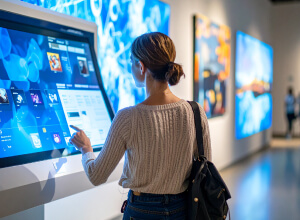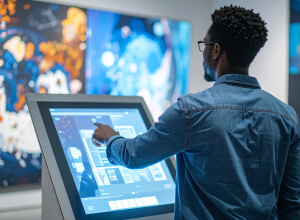How to Design the Perfect Digital Menu Board for Your Restaurant

In our previous blog post, we talked about the rise of digital menu boards in quick-service restaurants. Digital menu boards are becoming increasingly popular in restaurants as they provide an effective way to showcase your food options. In this blog post, we'll show how to design the perfect digital menu boards.
Design Tips Specific to Digital Menu Boards
Digital menu boards have become a mainstay in many restaurants and stores, but their design is anything but standard. Digital menus require special design consideration if they are going to be successful.

Invest in Quality Photos for Your Digital Menu Boards
Using high-quality images and videos is essential when creating digital menu boards. Digital displays rely heavily on visuals to engage customers, so low-resolution or blurry images can be a big turn-off. Make sure all images used are in high resolution and of consistent quality. Professional photos and editing can make a huge difference - just look at the difference between the burger featured in McDonald's advertisements versus what is actually served in restaurants! Investing in the production of captivating visuals for your digital menu board will ultimately lead to increased sales.

Use of Motion Graphics
Living Retail Lab performed an experiment to evaluate the efficacy of different types of visuals in digital menu boards (text-only, still images, and animated visuals). Surprisingly enough, it was determined that animated visuals are the most successful; consequently, sales grew by an impressive 800% when comparing all three variations.
Adding motion graphics to digital menu boards can give them a captivating and unforgettable advantage, making the food offered appear even more delicious.

Boost Your Special Promotions with Eye-Catching Takeovers
One great advantage of using digital menu signs instead of static boards is the capacity to animate your displays and grab customers’ attention. Consequently, if you want to feature a special promotion or limited-time offer (LTO), think about producing a grand 10-second complete takeover in which all boards display content for that particular item.
To tempt hungry customers, a vivid takeover with graphics and appealing sounds (frying, bubbling or clinking) may be all the convincing they need to purchase the highlighted item.

Ensure Your Digital Menu Boards are Clear and Uncluttered for Maximum Readability
Every component of your digital menu boards should bring a clear purpose. Don't overcrowd them with too many items; make sure to avoid clutter or excessive animation, as it can confuse customers. Instead of presenting everything at once, showcase the most popular products on your board and alter them frequently every few minutes. Try to stick to five or six menu items per digital display, as this will help keep your menu organized and easier for customers to read. This will keep customers engaged and allow you to introduce new offerings!

By clearly displaying your menu items and strategically utilizing blank space, you can reduce perceived wait times by up to 35%, providing a pleasant experience for your guests. Don't shortchange yourself; make sure that the content on your digital menu boards differs from what would be traditionally seen in static menus. This will allow you to unlock the full potential of these powerful tools.
Check Placeholder Text and Images Across All Variants
A major advantage digital menu boards have over traditional menus is that they can be updated in real-time and show different offers based on the time of the day or availability. As a result, your design will typically be comprised of placeholders.
It's essential to ensure that all placeholder text and images function correctly across all possible variants when designing digital menu boards. This is crucial to prevent problems arising from an incorrectly sized text or image. By allowing enough room for long text, you can ensure that all product names and descriptions conveniently fit on the digital menu board.

Improve Readability with Font and Contrast
When designing digital menu boards, designers must make sure that the fonts are easily readable from a distance. This is especially important because people standing in line could be more than 15 feet from the board. Choosing fonts that are large enough to be seen clearly at a distance can help improve readability and enhance the overall customer experience.
Contrast is also crucial when designing digital menu boards! Pick colors that make each item pop, using high contrast to make your text easier to read. That way, customers can quickly spot desired items and be more likely to order something. Different text sizes, colors, and font styles should also offer good contrast, creating a visually appealing menu that encourages people to explore available options. Plus, the contrast will make it easy to read your menu, even in low-lighting or bright environments. Don't forget to use a contrast checker tool, so you know if your choices are sure to be compliant with regional accessibility laws.
Size of Display Considerations
The size of the digital menu board should be carefully considered as it can significantly affect the user experience. Smaller boards provide a more focused view, while larger boards allow more information to be displayed simultaneously. The display size also impacts how much detail and design elements can be included in the menu board, such as font size, spacing, and layout design. Furthermore, a large display is recommended for an outdoor digital menu board to be easily seen from far distances. Careful thought should go into selecting the right size for your specific needs.
Integrate Presence Detection for Digital Menus
For digital menu boards, an exciting technology to consider is presence detection. Presence detection works by using sensors such as cameras or Wi-Fi to detect customers’ presence in a particular area and adjust the content accordingly. The technology can tailor the Digital Menu Board design to display only relevant information and offer tailored deals or discounts based on who is in front of the screen. Though this technology may not be practical for digital menu boards located in high-traffic areas, it could still benefit drive-throughs or other locations with less foot traffic.
.jpg)
Classic Menu Board Design Tips Applied to Digital Boards
Digital menu boards offer many of the same benefits as traditional analog menus but with the added advantage of being digital. Digital menu boards enable restaurateurs to create a dynamic and interactive customer experience. Digital displays can be programmed to show different items throughout the day or week, permitting restaurants to quickly and easily adjust their menus in response to customer demand.
Use Classic Menu Psychology
Menu psychology is a study of how a restaurant's menu can influence people to spend more money. Classic menu psychology can also be applied to digital menus. Techniques include creating a sense of scarcity: If people feel like they could miss out, then it's more probable that they'll act. To capitalize on this feeling of urgency, use phrases such as "limited-time offer," "hurry while supplies last," or even "24 hours only." To find out more, take some time to read this excellent article on menu psychology.
Menu Readability
Did you know that 74% of customers say an easy-to-read menu is their top priority (source)?
Digital displays often suffer from glare or reflection, making the text difficult to read. To counteract this, choose fonts with thick strokes and use contrasting colors for the background and text. Digital menu boards should also be designed to keep text within the “golden triangle” – this is an area of a digital menu board where people are most likely to look first.
Color Consistency

Digital displays often feature bright colors, but too many of them can be overwhelming to customers. Digital menus should use a limited color palette and consistent branding throughout the display. This will help create an inviting, eye-catching customer experience that encourages them to peruse your menu.
Use Design Elements to Direct People Reading the Menu
Digital menu boards can use design elements such as arrows, color coding, or bold text to direct customers toward specific items on the menu. Additionally, including food images alongside the description can make them more appealing and help draw people in. Digital displays are also a great way to promote special offers or discounts; highlight these with a bright color or bold font to make them stand out. Digital displays can also display static or rotating images that create an inviting atmosphere.
Put High Margin Products on the Right Side of the Menu

The right side of a digital menu board is prime real estate for high-margin items. Studies have shown that people are more likely to order items on the right side of a menu (source). Digital menus should be designed with this in mind, placing items with the highest chance of being ordered on the right side.
Updating your Digital Menu Board Design
Like all menus, digital menu boards must be updated regularly to reflect changing dishes, prices, or ingredients.
Taking Seasonal Preferences into Account
Ensuring any menu changes or updates account for seasonal preferences is essential. Different items may be more popular during certain months than others, such as salads and cold seafood dishes in the summer, while comfort items become more viable options during winter months. Understanding which items your restaurant's customers are most likely to go for at different times of the year should help provide a strong foundation upon which seasonal updates can be made - creating menus that remain relevant throughout the year.

Facilitate Updates Thanks to CMS
Content management systems are essential when designing digital menu boards. Content that is easy to modify, update, and control is a must for any business looking to keep its customers informed of the most up-to-date information. A CMS enables restaurants to stay on top of their constantly changing menu without having to update it themselves whenever they want to make a change. Additionally, CMS-enabled menus allow restaurant owners to customize the display according to their needs, such as size, font type and color, logo placement, etc. so that it always fits perfectly with their brand. It also allows them to remain in charge of their brand design since they can oversee and manage it remotely.
Examples Of Digital Menu Board Designs You Can Build with Intuiface Software
With Intuiface, you can create interactive digital menu boards designed to engage your customers and showcase a variety of menu options. Because Intuiface is not limited to templates, you can build any design you want. Digital menu board designers have the ability to customize the entire user experience and make it interactive! Use timers to rotate content, create a complete food ordering kiosk, or craft an interactive build-your-own dining experience. The possibilities are endless!
Feeling uninspired while designing your menu board? Refer to the below examples. These samples can be downloaded for free in Intuiface Composer and used as inspiration.
Restaurant Menu Template
Browse the interactive menu of a sushi restaurant. This experience captures the restaurant's ambiance and compliments menu items with high-definition graphics. Test out this interactive experience right here, made possible with Intuiface's web deployment support.
This is an Intuiface experience embedded for the web. Try it out! It's fully interactive.
More info about Intuiface & web publishing can be found here.
QSR Digital Menu Board Sample
This sample experience illustrates the use of Intuiface to create a digital menu board. Specifically, we display breakfast and lunch menus for a Quick Service Restaurant (QSR), with data pulled from cloud-hosted storage. Updates to content in storage are automatically reflected in the running experience, and a scheduler uses time-of-day to toggle between breakfast and lunch menu content.
QSR Fast-Food Ordering Kiosk
This retail transaction-based experience serves as a framework for your requirements and needs. Customize every aspect to create your own Retail experience.

Product Browser Example
You can also use this Brewery Browser sample that enables users to select beers and get more information about them.

All samples presented here are available for free when you run Intuiface Composer.
Conclusion
Digital menu boards are an effective way to engage customers and showcase a variety of options. Digital menus offer flexibility, permitting users to make changes quickly and easily with the help of content management systems (CMS). Whether you're looking for a digital menu board design that highlights daily specials or one that showcases seasonal items, Intuiface software provides the tools needed to create interactive digital menus explicitly tailored to your needs. With customizable fonts, colors, animations, and more - restaurant owners can have complete control over their digital menu design while providing an engaging customer experience. So take advantage of these creative tips today!
Sources:
https://www.sixteen-nine.net/2015/07/07/infographic-digital-menu-boards-businesses/
https://www.bizplay.com/blog/articles/how-bright-should-a-digital-signage-screen-be





